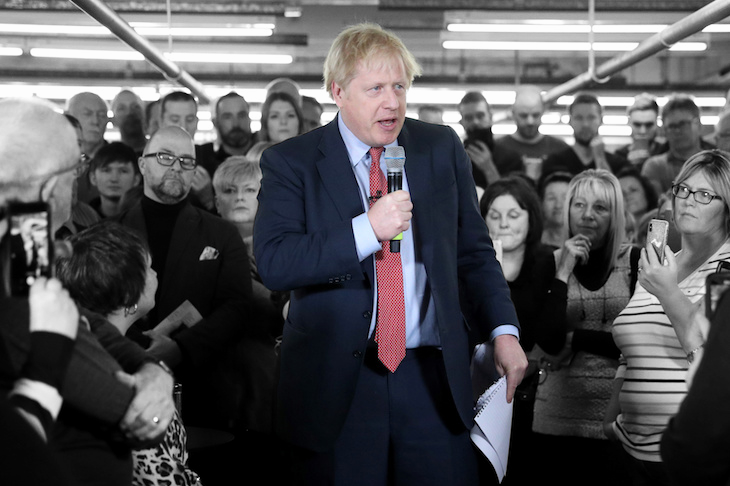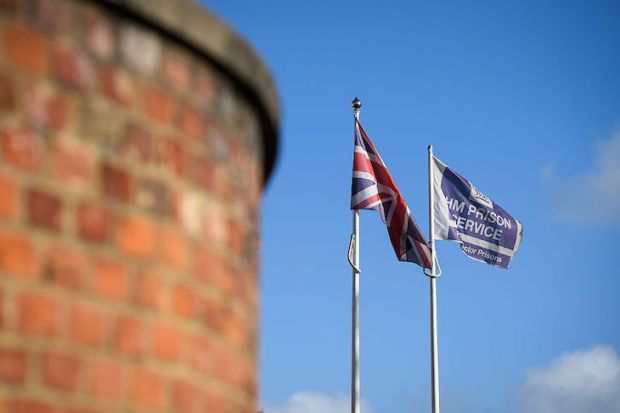Stump speeches and battle bus stop-offs are a staple of political campaigning. And while much of the battle for votes now happens online, as Katy Balls points out in this week’s Spectator, the constituency fly-by remains a central element of any party’s election schedule. So what can we learn about the Conservative strategy from Boris Johnson’s tour across the country? It could reveal that the Tories are starting to panic.
The Prime Minister’s campaign machine has shifted into a surprisingly defensive gear over the last week or so. Rather than descending on top target seats, Johnson is now focusing on Conservative held marginals. While his personal campaign tour has been interrupted by both a Nato summit and the attack on London Bridge, the underlying strategy appears to have changed from earlier on in the campaign.
Following the conclusion of the Nato summit on Wednesday, the PM visited Red Bull Racing in Milton Keynes, a town where both constituencies (Milton Keynes North and MK South) are held by the Tories. Both seats have majorities of just under 2,000, putting them firmly within the standard definition of a marginal. However YouGov’s MRP poll predicted that the two constituencies would be held by the party with the Labour vote share in both expected to fall.
This late stage strategy – of visiting threatened Tory seats over Labour or Lib Dem marginals – was also apparent during a two-day visit to the South West last week. Johnson stopped off in the constituencies of Camborne & Redruth, Truro & Falmouth and St Ives on 27 November. All three seats are blue and were held by the Tories in the 2017 election.

Boris Johnson visiting the Goonhilly Earth Station in Helston, in the constituency of St Ives last week
It’s true St Ives does have the fourth smallest majority of any Conservative held seat and the Lib Dems have been closing the gap over the last two elections. But it is also a constituency with a slightly higher Leave vote than the national average and a Lib Dem candidate keen to down play his party’s national revoke message. The other two seats Johnson visited that day also fall within the bracket of a marginal (i.e. held with a majority of less than 5,000) but again are projected to remain Tory.
Earlier in the campaign, Johnson seemed to take a more strident approach. Two weeks ago he was visiting Middlesbrough and Sedgefield. Only Middlesbrough South is held by the Tories, the party having won it in 2017 with a majority of just over a thousand. The constituency of Middlesbrough itself looks like a Labour stronghold, having returned a red-rosetted candidate at every election since the seat was reintroduced in 1974. Sedgefield is Tony Blair’s former seat, currently held by Labour with a majority of 6,000. The constituency, which backed Brexit by almost 60/40, has been seen by some as electoral weathervane – traditional Labour heartland but susceptible to the pressures of a new political environment. If the Tories take Sedgefield then Labour are all but finished.

Boris Johnson visiting Red Bull Racing in Milton Keynes on Wednesday
Johnson’s move away from Labour marginals to vulnerable Tory seats has striking similarities to Theresa May’s doomed campaign in 2017. The former Prime Minister started her campaign in seats like West Lancashire, a seat that has been Labour since 1992 and where the party’s majority actually increased between 2015 and 2017. As election day loomed, May finished her campaign in places like Plymouth where the Tories ended up losing one of the city’s three seats to Labour.
Similarly, the Boris Johnson made his first big speech of the campaign in mid-November at an electric vehicle factory in Coventry. The three constituencies that make up the city, Coventry North West, North East and Coventry South, are all Labour held with majorities ranging from around 8,000 to 15,500.
Yet again, we can see how this campaign has also been defined by two halves. All three of the Coventry seats backed Leave and two of the three former MPs have stepped aside at this election. The YouGov projections put North West and South Coventry at a two and three point difference respectively. In other words, they are within the margin of statistical error and eminently winnable. Boris’s opening gambit was clearly focussed on winnable Labour-held seats.

Theresa May in Plymouth towards the end of the 2017 general election campaign
So why does it look as though Boris Johnson’s personal campaign strategy has changed? It’s worth bearing in mind the particular calculations of a party leader’s visit. The leader is a visual embodiment of the campaign and the party itself. So while Boris Johnson can draw media attention to a particular constituency or candidate, he also brings with him an inherent risk.
Take yesterday’s outing to Matlock in the parliamentary seat of Derbyshire Dales (a Tory safe seat with a 14,000 strong majority) from where Boris Johnson laid out his plans for his first 100 days in office. Protesters surrounded the campaign bus shouting slogans and waving placards as the Tory leader made his way into the venue.
BREAKING: Protestors have surrounded the Conservative campaign bus as Boris Johnson arrives in Derbyshire pic.twitter.com/uq2SK9hyY9
— Paul Brand (@PaulBrandITV) December 5, 2019
Driving the Boris battle bus deep into Labour territory runs an even higher risk. Videos showing disgruntled door knocks or angry activists could spread online just as voters are making up their minds. This is why many of the visits seem to be taking place in closed environments like factories or markets. It’s easier for the PM’s minders to control how the event will unfold and therefore how the campaign is perceived. Conservative strategists may have also calculated that Johnson is better at energising reluctant Tories rather than convincing swing voters.
The overall story of this Conservative election campaign has been one of risk avoidance. The policy-light manifesto was perhaps the clearest example of this strategy. It’s why Johnson has done everything he can to avoid the scrutiny of journalists like Andrew Neil, who the party confirmed this morning would not be grilling the Prime Minister.
The Tories’ top campaign strategist, Isaac Levido, has reportedly told staff that this final stage should be like a ‘closing statement’ in a trial. The Conservatives will be praying for the right verdict rather than a hung jury.
Got something to add? Join the discussion and comment below.
Get 10 issues for just $10
Subscribe to The Spectator Australia today for the next 10 magazine issues, plus full online access, for just $10.




















Comments
Don't miss out
Join the conversation with other Spectator Australia readers. Subscribe to leave a comment.
SUBSCRIBEAlready a subscriber? Log in